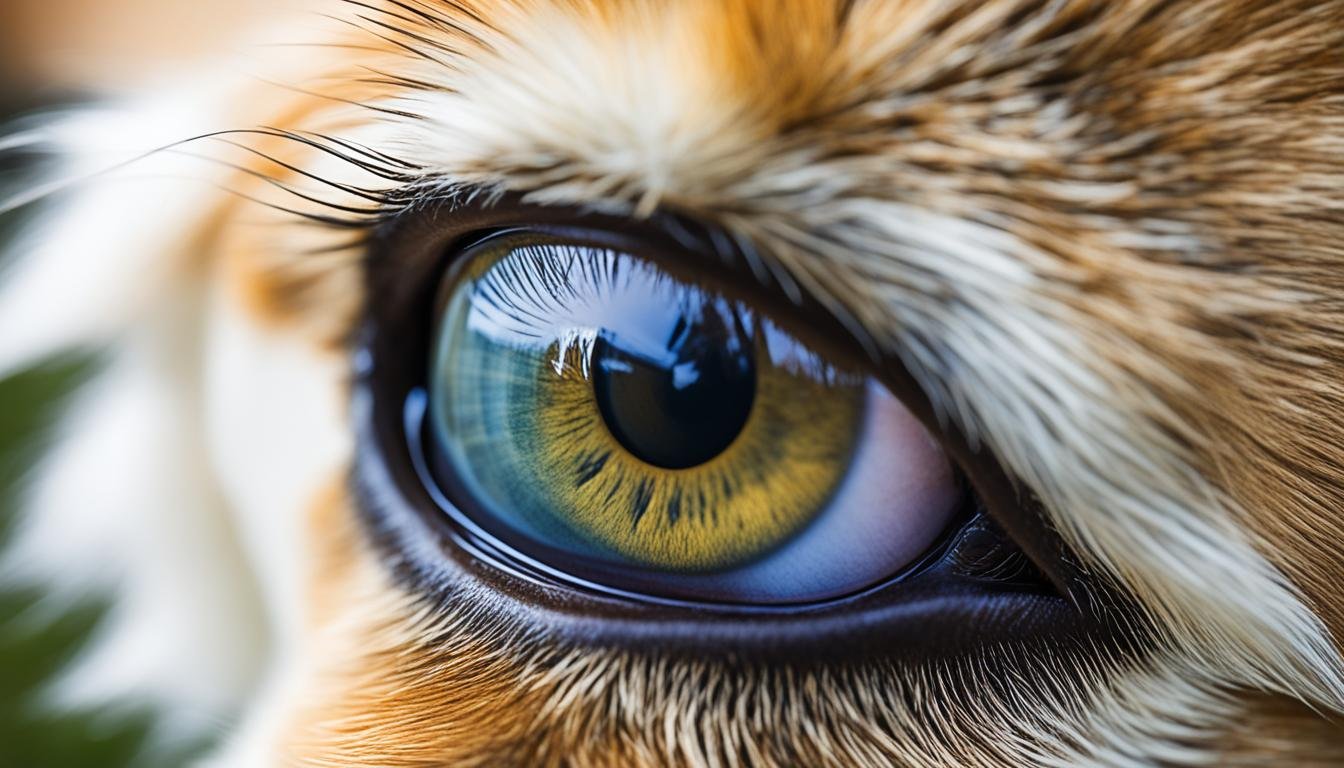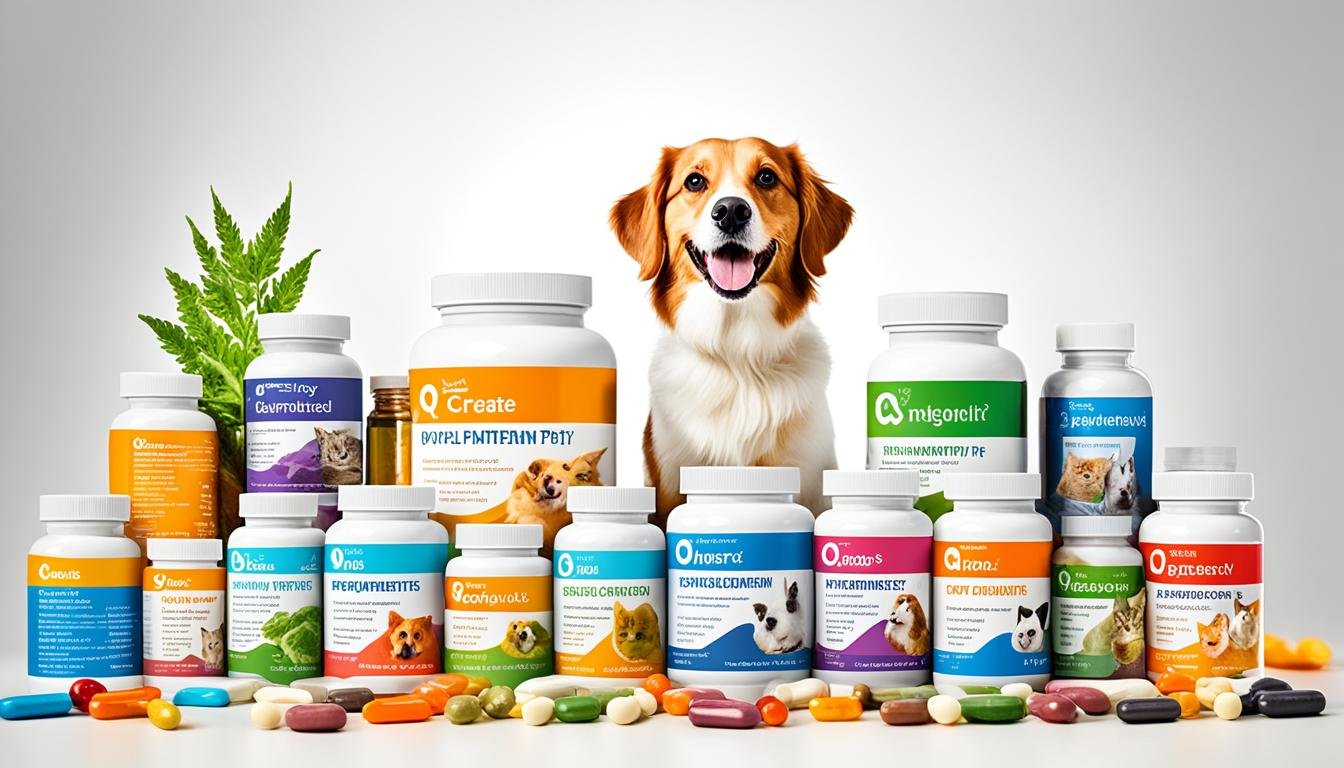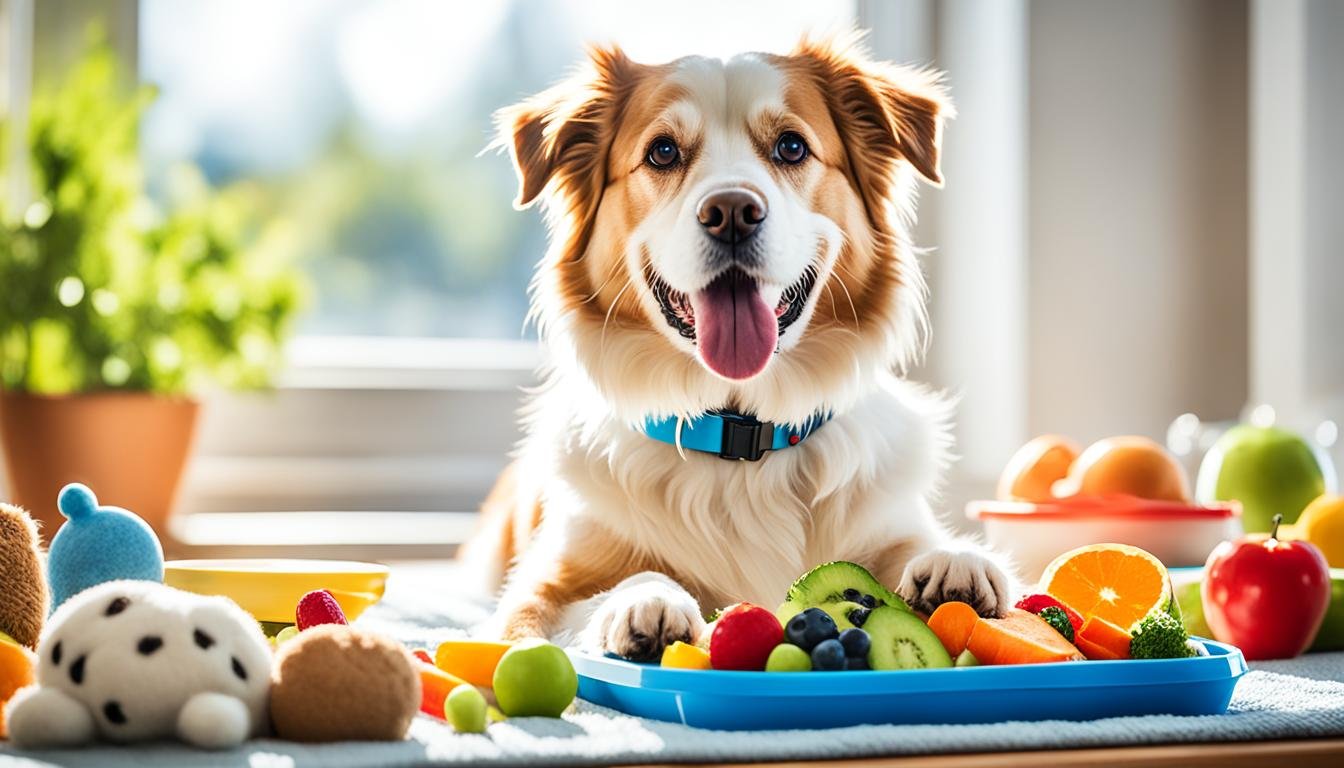Welcome to our comprehensive guide on pet eye care! As a responsible pet owner, ensuring the health and well-being of your furry companion is of utmost importance. One aspect of pet care that often goes overlooked is maintaining proper eye health. Just like humans, pets can experience various eye problems that can impact their vision and overall quality of life. In this article, we will provide you with essential pet eye care tips to help you ensure the healthy vision of your beloved furry friend.
Proactive pet eye care is crucial as it can help prevent common eye problems and detect any potential issues early on. Regular care, preventive measures, and proper treatment are key to maintaining optimal pet eye health. Whether you have a dog, cat, or any other pet, these tips will be applicable to all. By implementing these recommendations, you can contribute to your pet’s long-term eye health and happiness.
Throughout this article, we will cover a range of topics related to pet eye care. We will delve into understanding pet eye anatomy, common eye issues in pets, preventive measures, and methods for recognizing and addressing pet eye problems. Furthermore, we will explore holistic approaches to pet eye care and discuss the significant role of pet eye specialists and veterinary ophthalmologists in delivering specialized care.
Understanding Pet Eye Anatomy and Common Eye Issues
When it comes to caring for your pet’s eyes, it’s essential to have a basic understanding of their anatomy and be aware of common eye issues that they may face. By familiarizing yourself with the structure of your pet’s eyes and the potential problems that can occur, you’ll be better equipped to recognize any signs of eye issues and seek appropriate care.
Pet Eye Anatomy
The anatomy of a pet’s eye is similar to that of humans, consisting of several essential components. These include:
- Sclera: The tough, white outer layer that forms the visible white part of the eye.
- Cornea: The transparent layer at the front of the eye that helps focus light into the eye.
- Iris: The colored part of the eye that controls the size of the pupil and regulates the amount of light entering the eye.
- Pupil: The black circular opening in the center of the iris that allows light to enter the eye.
- Lens: A clear structure located behind the iris that focuses light onto the retina.
- Retina: The innermost layer of the eye that contains cells responsible for converting light into electrical signals for the brain to process.
These are just a few key components, but the eye is a complex organ with many intricate structures that work together to provide vision. Understanding these structures can help you appreciate the importance of maintaining your pet’s eye health.
Common Eye Issues in Pets
Unfortunately, pets can experience a range of eye problems, some of which include:
- Conjunctivitis: Also known as “pink eye,” this condition involves inflammation of the conjunctiva, the thin membrane that covers the front of the eye.
- Cataracts: A clouding of the lens that can cause vision impairment, often associated with aging or certain medical conditions.
- Glaucoma: An increase in pressure within the eye that can lead to irreversible damage to the optic nerve if left untreated.
- Corneal ulcers: Open sores on the cornea, typically caused by trauma or underlying infections.
- Cherry eye: A condition where the gland of the third eyelid becomes inflamed and protrudes, resulting in a red, fleshy appearance.
- Entropion: A condition where the eyelid folds inward, causing the eyelashes to rub against the cornea, leading to irritation and damage.
These are just a few examples of the eye issues that pets can experience. It’s important to be vigilant and seek veterinary care if you notice any signs of discomfort, redness, discharge, squinting, or cloudiness in your pet’s eyes.
Now that you have a better understanding of pet eye anatomy and common eye issues, you can proactively monitor your pet’s eye health and seek appropriate care when needed.
Preventive Measures for Pet Eye Care
Ensuring the long-term health of your pet’s eyes requires proactive preventive measures and regular care. By implementing simple practices and habits, you can minimize the risk of eye-related issues and promote optimal eye health for your furry friend.
Pet Eye Hygiene
Effective pet eye hygiene plays a crucial role in preventing eye problems. Regularly cleaning your pet’s eyes not only removes dirt and debris but also helps prevent the buildup of harmful bacteria. Follow these steps to maintain proper pet eye hygiene:
- Gently wipe your pet’s eyes with a clean, damp cloth to remove any discharge or crust.
- Use a veterinarian-approved eye cleanser to cleanse and soothe the delicate eye area.
- Trim long hair around your pet’s eyes to prevent it from irritating the eyes or obstructing vision.
- Take care when using grooming products near the eyes to avoid accidental contact.
Remember: If you notice any redness, excessive tearing, or irritation, consult a veterinary professional for further guidance.
Regular Eye Examinations
Regular eye examinations by a veterinary ophthalmologist are crucial in identifying and addressing potential eye problems before they progress. These specialized eye examinations can detect underlying issues that may not be apparent to the naked eye. By scheduling routine eye check-ups for your pet, you can ensure early diagnosis and prompt treatment if required.
“Regular eye examinations are essential for maintaining your pet’s eye health and catching any potential problems early on. Don’t wait for obvious symptoms—be proactive in scheduling routine check-ups with a veterinary ophthalmologist.” – Dr. Samantha Martinez, Veterinary Ophthalmologist
During these examinations, the veterinary ophthalmologist will evaluate various aspects of your pet’s eyes, including:
- External eye structures
- Cornea and lens
- Eye pressure
- Retina and optic nerve
Based on the findings, the specialist can provide recommendations, prescribe appropriate medications, or suggest further diagnostic tests if needed. Remember, preventive care through regular eye examinations is key to maintaining your pet’s eye health and ensuring a lifetime of clear vision.
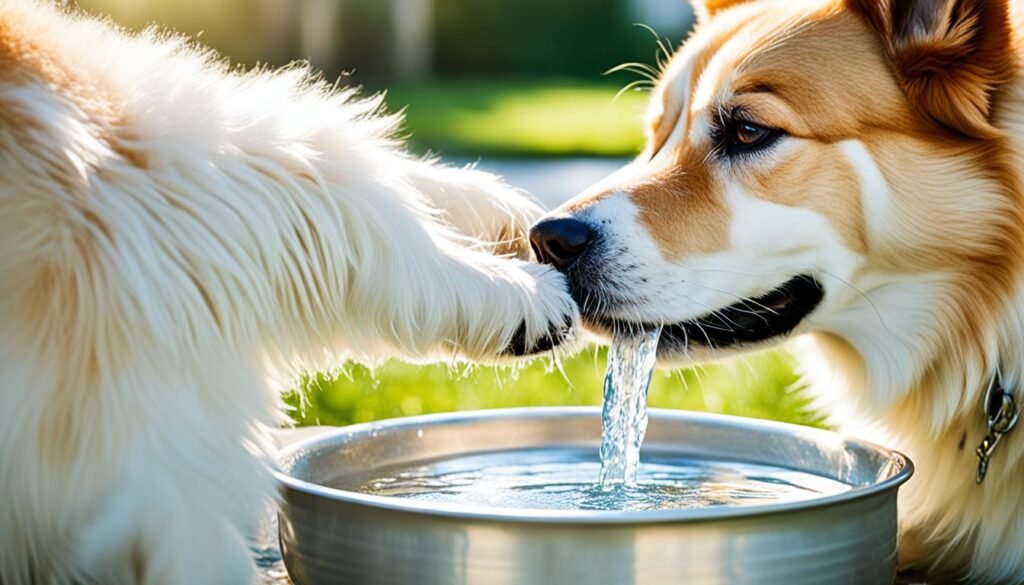
Recognizing and Addressing Pet Eye Problems
As responsible pet owners, it’s essential to be vigilant and knowledgeable about potential eye problems that our furry friends may encounter. By recognizing the early signs of pet eye problems, we can take prompt action and ensure that our pets receive the necessary care and treatment from veterinary professionals.
Here are some common symptoms that may indicate eye issues in pets:
- Redness: If you notice redness in your pet’s eyes, it could be a sign of irritation, infection, or inflammation.
- Discharge: Excessive or abnormal eye discharge, such as a thick or colored discharge, can indicate an underlying problem.
- Squinting: Pets may squint or blink frequently to protect their eyes from pain or discomfort.
- Cloudiness: Cloudy or opaque eyes can be a symptom of cataracts or other serious eye conditions.
It’s important to remember that these symptoms may vary depending on the specific issue. If you observe any of these signs in your pet, it’s crucial to seek veterinary care for a proper diagnosis and treatment plan.
When addressing pet eye problems, it’s crucial to trust the expertise of veterinary professionals who specialize in eye care. A veterinary ophthalmologist can perform comprehensive eye exams, diagnose specific conditions, and recommend appropriate treatment options.
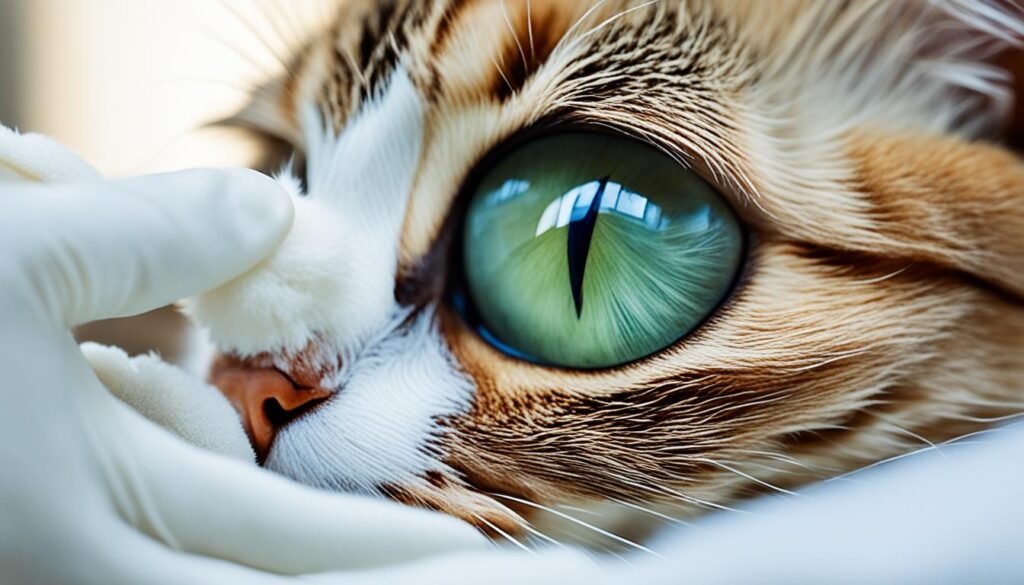
In some cases, your pet may require specialized procedures or surgeries to address complex eye issues. Veterinary ophthalmologists are well-equipped to provide these specialized treatments and ensure the best possible outcome for your pet’s vision and overall well-being.
In summary, recognizing and addressing pet eye problems is crucial to maintaining your pet’s ocular health. By staying alert to symptoms such as redness, discharge, squinting, and cloudiness, and seeking veterinary care, you can ensure that your beloved furry companion receives the necessary care and treatment for optimal eye health.
Holistic Approaches to Pet Eye Care
When it comes to caring for your beloved pet’s eyes, holistic approaches offer natural remedies and preventive measures that can support their eye health. By incorporating holistic practices into your pet’s care routine, you can address common eye issues and promote optimal vision. In this section, we will discuss holistic pet eye care, natural remedies for pet eye issues, and the role of diet and nutrition in maintaining your pet’s eye health.
Natural Remedies for Pet Eye Issues
Natural remedies can help alleviate and prevent common eye issues in pets. Homeopathic solutions and herbal treatments are gentle alternatives to traditional medications. For example, chamomile tea can be used as a soothing eye rinse to reduce inflammation and irritation. Additionally, calendula extract can help soothe dry and itchy eyes. When considering natural remedies, it’s important to consult with a holistic veterinarian to ensure the appropriate remedies are used for your pet’s specific needs.
Diet and Nutrition for Pet Eye Health
Proper nutrition plays a vital role in maintaining optimal eye health for your pet. A balanced diet rich in antioxidants, vitamins, and minerals can support their overall eye health. Include foods that are high in omega-3 fatty acids, such as salmon or flaxseed, as they can help reduce inflammation and promote healthy eyes. Carrots and leafy greens are also beneficial for their vitamin A content, which is essential for good vision. Consult with your veterinarian to create a tailored diet plan that suits your pet’s individual needs.
Remember that holistic approaches should always complement veterinary care. If your pet experiences persistent or severe eye issues, it’s crucial to seek professional advice from a veterinary ophthalmologist or animal eye care specialist.
Now that we’ve covered holistic pet eye care, let’s dive into the role of pet eye specialists and veterinary ophthalmology in the next section.

The Role of Pet Eye Specialists and Veterinary Ophthalmology
When it comes to the health of our beloved pets, their eyes require specialized care just like ours. That’s where the expertise of pet eye specialists and veterinary ophthalmologists comes into play. These professionals have extensive knowledge and training in animal eye care, ensuring that your pet’s vision and eye health are in good hands.
Pet eye specialists are highly skilled in diagnosing and treating complex eye conditions that can affect pets. Whether it’s a congenital issue, trauma-related injury, or a chronic eye disease, these specialists have the expertise to create tailored treatment plans for your pet’s individual needs. They utilize advanced diagnostic techniques and specialized equipment to accurately assess your pet’s eye health and determine the best course of action.
Veterinary ophthalmology is a specialized field that focuses on the diagnosis and treatment of eye diseases in animals. These professionals work closely with pet owners and primary care veterinarians to ensure comprehensive and effective eye care. They can provide specialized treatments such as surgeries, laser therapies, and medications to address various eye conditions and improve your pet’s quality of life.
When it comes to the well-being of your furry friend, it’s essential not to overlook their eye health. By understanding the role of pet eye specialists and veterinary ophthalmology, you can ensure that your pet receives the specialized care they need. So, if you notice any signs of eye problems or have concerns about your pet’s vision, don’t hesitate to consult a pet eye specialist or veterinary ophthalmologist. They are dedicated to providing the best possible eye care for your beloved companion.
